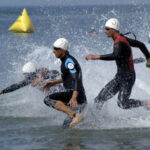Packing for any excursion can represent a challenge for virtually anyone. Week-long family vacations to Disney, or a weekend away at the in-laws, requires forethought and planning, especially if you do not want to be left wishing you had something that is probably sitting on the top of your dresser at home. This feeling of aggravation can frustrate anyone, especially if you are a first-time triathlete who digs down into his bag minutes before hitting the water to find out that he has left his goggles at home, or goes to set up his bike in transition one only to realize his cycling shoes are next to the front door, right where he left them so he would not forget. You can borrow sunscreen or towels on a vacation, but I seriously doubt if the triathlete next to you will have an extra helmet or wetsuit for you to use. Thus, organizing a clear, detailed packing list that you check and recheck prior to traveling to your event is an absolute requirement.
The following lists will allow the first-time triathlete to make sure he has everything he will need to make that first experience a rewarding and successful one. Just like in your training, ultimate preparation will pay off.
Items to put in your triathlon bag:
1.Sunscreen, chapstick, and body glide: The lubricant will prevent serious post-race soreness and chaffing. The sunscreen will take care of the forever exposed neck and arms during those long runs on heat reflective pavement. The chapstick will stop dry lips from becoming a needless hindrance after a windy bike ride or salty swim.
2.Race information and USAT license: Keep the packet you receive with all of the race details-start times, wave times, course maps, rules, etc.-handy at all times. The beginning of a race can get hectic, with hundreds of people walking around. Also, if you are a member of USA Triathlon, carry the license with you at registration/check-in. This paperwork will make life easier for you.
3.Towels: You will need a few. One for the transition following the swim and a few others to wipe away sweat and dry off after the completion of the race.
4.Transition Bag: One way to make sure you have all the required items for both transitions is to have two bags packed with that equipment. Label each bag “T1” or “T2”.
5.Energy and Hydration: Keeping a small stash of energy bars, gels, and drinks will allow you to refuel as needed during the race. Filling and chilling the water bottles for the bike portion and placing them on the bike before the race will save time and avoid slowdowns at water stations.
6.Clothing and footwear: Having a warm-up suit for cool, predawn preparation is a must. Extra shirts, socks, and foul weather gear will only make your experience more pleasant in the event of the unforeseen rain storm. Also, a comfortable pair of sandals to wear during the post-race festivities will certainly pay your feet back for the hours of abuse you inflicted on them.
7.Personal First-aid Kit: While the medical support at most triathlons is excellent, you should have a small kit that will allow you to remedy any small cuts or bumps you may have garnered along the way.
8.Watch, Monitors, Sharpies, and More: If you train with a heart monitor, by all means have it with you during the competition. Also, if you are a numbers person, keep that sports watch comfortably attached, just as you would during training. Making the real experience like training only increases your comfort and confidence. Bring along a thick sharpie to do any required body markings, and do not forget a credit card or some emergency cash-you never know.
Items to organize for you swim portion:
1.Swimsuit or triathlon suit: Whichever you select, make sure it is washed and prepared for race day. It should be slim fitting and fit under a wetsuit, if you wear one.
2.Goggles: It would be easier to swim naked pulling a piano than to go without goggles. Check and double check this. Also, bring along a second pair as back up. If a strap breaks or a leak develops, you’ll want that second pair around pretty fast.
3.Wetsuit: Most competitors elect to wear a wetsuit. Whether it be a shortie, a full length one, or a sleeveless version, check it over and throw it in the bag. You will want this for extra buoyancy or if that water temperature dips too low. They really help with those pesky jellyfish also.
4.Swim Cap: While you may have trained with your favorite cap, you will need to wear the one provided by the race crew. The color will signify your age group and wave. Cannot swim without it.
Items to pack for the bike portion:
1.Bike: Make sure the tires are pumped and everything is lubed up. Do your final adjustments during warm-ups, and then leave it in the T1 zone.
2.Shirts, Jersey, and Helmet: Snap the helmet on the handlebars of the bike. You will not be allowed to leave the transition zone without the helmet properly snapped to your head. Have a comfortable jersey that is slim-fitting to reduce wind resistance, and make sure to have a padded pair of cycling shorts. If you’re wearing a triathlon suit, the jersey and shorts are already taken care of.
3.Cycling Shoes: Unless you are wearing slide-in clips and running sneakers, you will need to pack your shoes. Either have them right next to the bike, or, if you are really good, have them already attached the pedals.
4.Sunglasses: Absolutely critical on the bike. Put them in your helmet or on the neck on the bike. Forgetting these will hurt.
5.Race Wheels: If you train with different wheels than you race, do not forget to change these over. Make the switch the night before to avoid any unforeseen issues. Never do it last minute.
6.Tools and pumps: Keeping a small bag of bike tools, spare tubes, patches, and a tire pump will help you maintain the bike and repair it as needed. Carrying a tube and pump with you during the race could help you fix that unfortunate flat.
7.Computer: Many riders have a cyclometer or computer on board to gauge speed, distance, etc. If you rely on this during training, keep it on the bike and use it to your advantage.
8.Your Number: You will need to put a number on your bike or helmet-usually a sticker of some kind, and you will have to attach a bib number to your jersey. If you like wearing a race belt, then snap the number card on there before the race and leave the belt hanging on the handlebars of the bike. You need to have your number present and visible when leaving the transition zone.
Items to pack for the run portion:
1.Sneakers: Bringing with you a pair of trainers as well as racing flats will allow you to warm-up and compete just like you train. Most first-time triathletes have a pair of running sneaker only. Check the laces to make sure they will not snap when you tie them in a hurry. Look inside to get out any small stones or debris that may have gotten into the shoes. You do not want that little bump or chip of something bothering you during the run. Not only will it hurt your foot, but also it will play with you mentally.
2.Shorts and Tops: Unless you are wearing a triathlon suit, you will need shorts and a top. Getting quality running gear that wicks moisture will help. You may choose to run in tri-shorts-shorts designed especially to be used on all three legs of the triathlon. Make sure you have your race belt with number or have the number bib fastened to the shirt for the run.
3.Socks: Pack a couple of pairs. They should be thin and moisture-wicking. Invest in quality socks. Your feet will thank you afterwards.
4.Hat or Visor: A long run on a hot day will show you the value of a hat. Keeping the sun from directly hammering your face will let you feel cooler and more energized.
5.Hydration belt: Some elect to wear a small belt that houses places for gel fuels and miniature water bottles. If you think you will need additional fuel between hydration stations on the course, consider using one of these. Train with it first, as running with something around your waist for the first time during competition could be aggravating and cumbersome.
In the end, double check each piece of equipment you bring, and try to anticipate even the weirdest situations you may encounter. It is always better to be over-prepared than left without. Following the list above will help you have an enjoyable first experience with the sport of triathlon.





